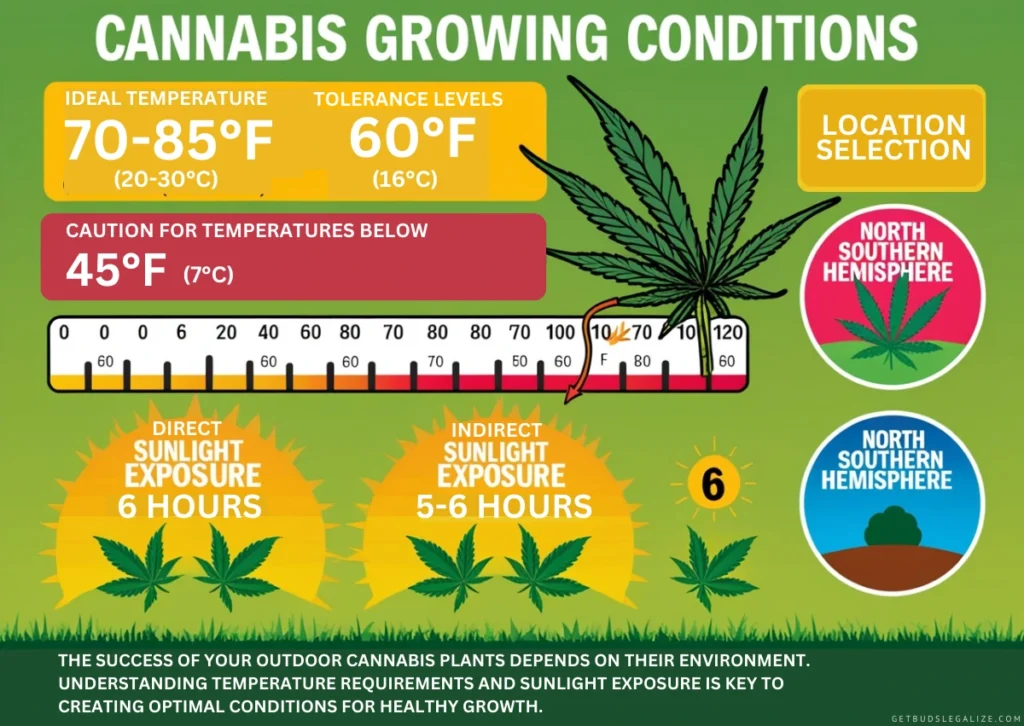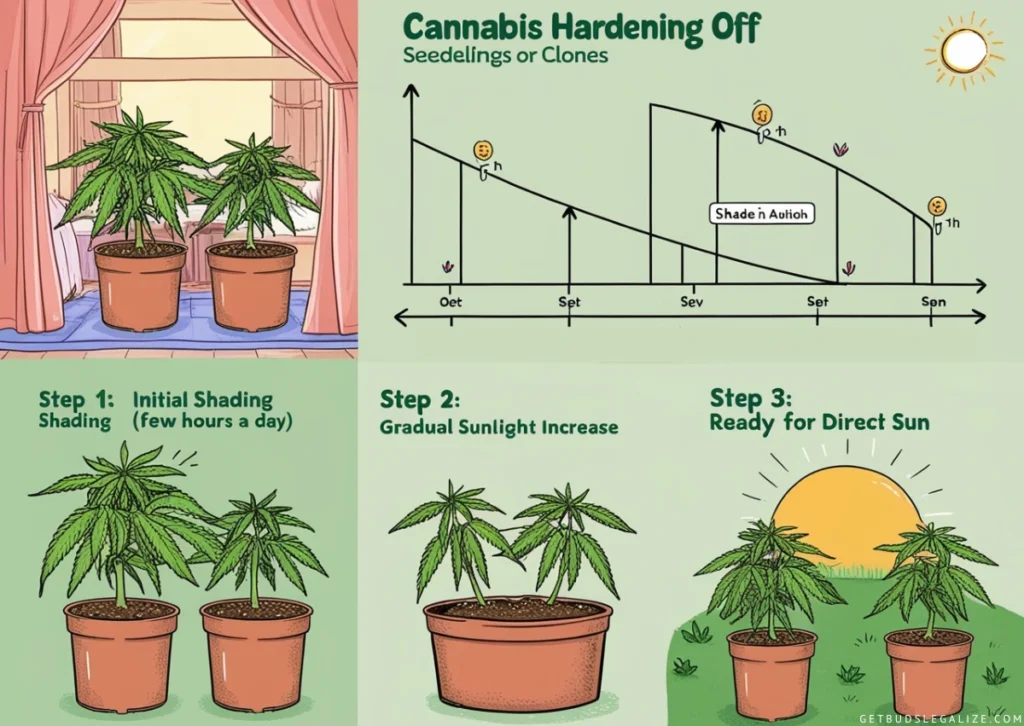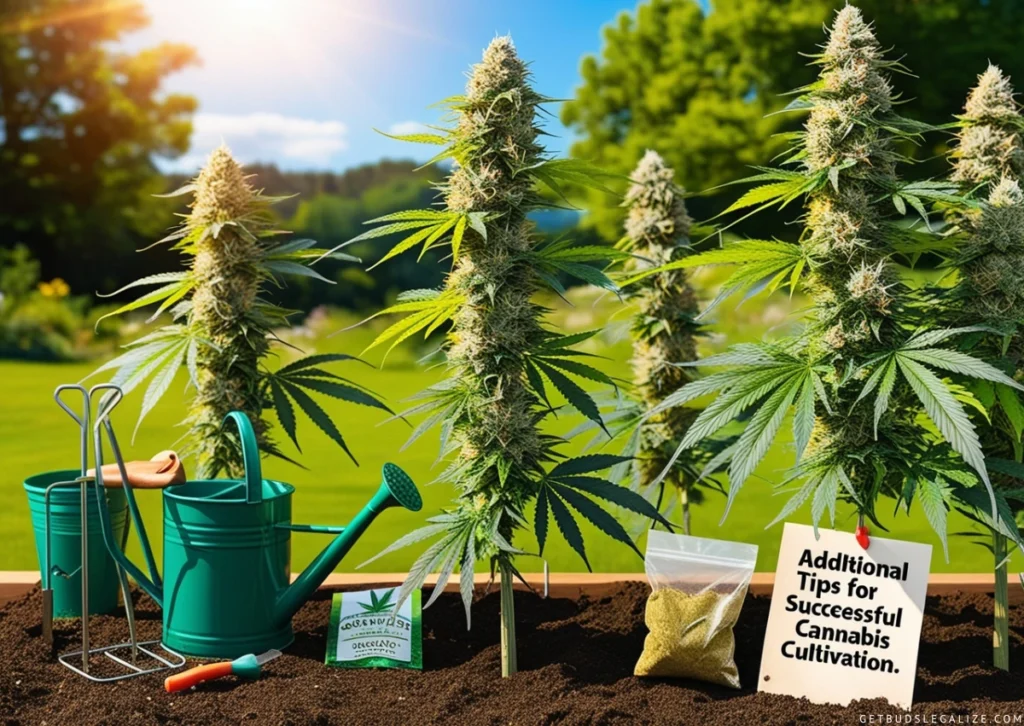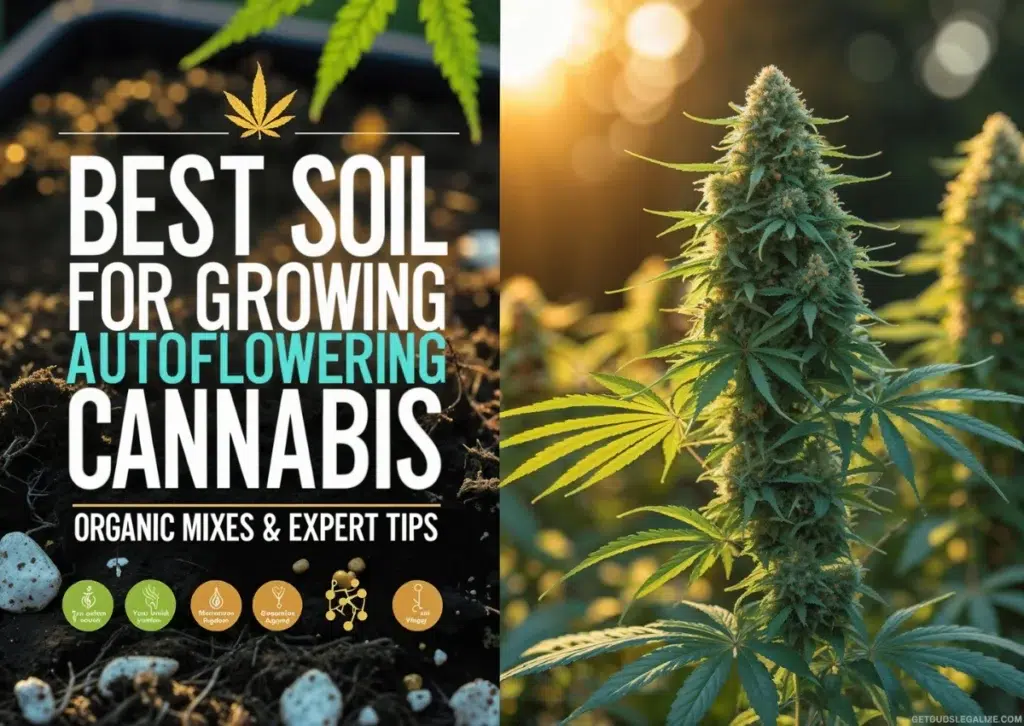How to Grow Cannabis Outdoors: Understanding the Basics of Outdoor Cannabis Cultivation
Growing cannabis outdoors can be a rewarding venture, offering the potential for abundant yields and vibrant, flavorful buds. However, before embarking on your cultivation journey, it’s essential to understand the fundamentals of how to grow cannabis outdoors that can influence the success of your plants. This guide will explore key aspects of outdoor cannabis cultivation, including legal regulations, ideal growing conditions, soil preparation, and the pros and cons of planting in the ground versus using containers.
1. Know the Legal Regulations
Before you begin growing outdoors, it’s crucial to familiarize yourself with the legal regulations in your area. Navigating these laws can help you avoid fines and ensure a smooth growing experience.
Check Local Laws
Understanding local laws is your first step. Regulations regarding cannabis cultivation can vary significantly by state and even by municipality. Here are some important considerations:
- State and Federal Laws: Verify both state and federal laws regarding cannabis cultivation. Some areas may require registration or enrollment in a medical program to grow marijuana legally.
- Plant Restrictions: Familiarize yourself with limitations on the number, size, and maturity of plants you can cultivate. Some local regulations may also prohibit visible outdoor growth.
States Permitting Outdoor Cannabis Cultivation
It’s helpful to know which states permit outdoor cannabis cultivation, often with specific restrictions:
- Full Legalization (with restrictions): Alaska, California, Colorado, Maine, Massachusetts, Michigan, Nevada, Oregon, Vermont, Washington D.C.
- Medical Use Only (with restrictions): Arizona, Hawaii, Illinois, Missouri, Montana, New Mexico, Oklahoma, Rhode Island.
2. Ideal Growing Conditions

The success of your outdoor cannabis plants heavily relies on the environment in which they are grown. Understanding temperature requirements and sunlight exposure will help you create the optimal conditions for healthy growth.
Temperature Requirements
- Optimal Range: Cannabis thrives in specific temperature ranges. Ideal daytime temperatures are between 70-85°F (20-30°C), promoting healthy growth and bud development.
- Tolerance Levels: Cannabis can tolerate temperatures as low as 60°F (16°C), but exposure to temperatures below 45°F (7°C) can significantly hinder growth. Starting your growing cycle in spring is advisable to avoid harsh cold weather.
Sunlight Exposure
- Direct Sunlight: Aim for a location that receives 6 hours of direct sunlight daily, along with an additional 5-6 hours of indirect sunlight.
- Location Selection: In the Northern Hemisphere, choose a south-facing spot for maximum sunlight exposure, while a north-facing location is ideal in the Southern Hemisphere.
3. Soil Preparation and Container Selection

Soil quality and container choice play a pivotal role in the health and yield of your outdoor cannabis plants.
Soil Mixing for Optimal Drainage
- Soil Type: Use either soil or coco coir as your growing medium. Coco coir is particularly effective in hot climates due to its loose structure, which helps prevent heat stress.
- Perlite Addition: Blend your chosen medium with 30% perlite to improve drainage, ensuring a healthy environment for root growth.
Choosing the Right Containers
- Container Options: If regulations limit plant size, using containers can help control growth. Fabric pots are preferable to plastic containers, as they allow for better air circulation to the roots.
- Container Size: Standard container sizes range from 10 to 20 gallons (38-76 L). Consider using larger containers, such as up to 100 gallons (380 L) for maximum growth and yield.
4. Planting in the Ground vs Containers
Both in-ground and container planting have their advantages. Understanding these can help you choose the best option for your cultivation style.
Planting in the Ground
- Maximize Yield: Planting directly in the ground allows roots to expand freely, enabling plants to reach their full potential. Space your plants at least 6 feet (1.8 m) apart to prevent overcrowding.
- Discreet Cultivation: Consider planting in raised beds alongside vegetables or flowers for a more discreet cultivation approach.
Container Planting
- Mobility and Control: Growing in containers offers mobility, allowing you to move plants for optimal sunlight exposure or to protect them from harsh weather conditions.
- Soil Control: Containers also give you the flexibility to experiment with different soil blends, ensuring your plants have the best possible growing environment.
5. Best Strains for Outdoor Cannabis Growing

When it comes to outdoor cannabis cultivation, selecting the right strain is crucial for maximizing your yields and ensuring healthy growth. Certain strains are better suited for outdoor environments due to their resilience to varying weather conditions, pest resistance, and overall growth patterns. Here are some of the best cannabis strains for outdoor growing:
5.1. Blue Dream
Blue Dream is a well-rounded hybrid known for its balanced effects, offering users a euphoric yet calming high. Its sweet, berry-like flavor makes it a favorite among many cannabis enthusiasts.
This strain flourishes in warm, sunny climates and can reach impressive heights of up to 10 feet (3 meters) outdoors. Blue Dream requires plenty of sunlight and good airflow to thrive.
It is renowned for its high yield potential, often producing generous quantities of potent buds, making it a top choice for outdoor growers looking for a bountiful harvest.
- Terpenes: Myrcene, Geraniol, Caryophyllene, Carene, Linalool, Ocimene
- Flowering Time: 9 to 10 weeks
- Outdoor Yield: 15-20 ounces per plant (425-600 grams)
5.2. Green Crack
Green Crack is famous for its invigorating effects and zesty citrus flavor. This sativa-dominant strain provides an energetic high that is perfect for daytime use, making it ideal for those needing a boost in creativity and motivation.
Green Crack performs best in warm climates and is notably resistant to common pests and diseases, making it a resilient choice for outdoor cultivation. With a flowering time of approximately 7 to 9 weeks, it can deliver moderate to high yields, especially when provided with optimal growing conditions.
- Terpenes: Myrcene, Valencene, Caryophyllene, Pinene, D-Limonene, Phellandrene
- Flowering Time: 7 to 9 weeks
- Outdoor Yield: 18-20 ounces per plant (500-570 grams)
5.3. Super Lemon Haze
Super Lemon Haze is a vibrant sativa-dominant strain that captivates with its refreshing lemon flavor and uplifting, euphoric high. This strain is ideal for social events or sparking creativity.
It thrives in sunny, dry climates, requiring ample sunlight, and is well-suited for outdoor cultivation. Known for its substantial yields, Super Lemon Haze rewards growers with an abundant harvest, particularly when nurtured in ideal growing conditions.
- Terpenes: Caryophyllene, Terpinolene, Myrcene, Humulene, Carene
- Flowering Time: 9 to 10 weeks
- Outdoor Yield: 20-35 ounces per plant (560-1000 grams)
5.4. Northern Lights
Northern Lights is a legendary indica strain recognized for its calming effects and rich, earthy flavor. It’s perfect for relaxation and unwinding after a long day, making it a go-to choice for those seeking tranquility.
This strain adapts well to various climates, exhibiting resistance to many pests and diseases, which makes it beginner-friendly. Typically offering a high yield, Northern Lights is favored by outdoor growers for its reliability and ease of cultivation.
- Terpenes: Myrcene, Limonene, Caryophyllene, Terpinolene, Phellandrene
- Flowering Time: 7 to 9 weeks
- Outdoor Yield: 14-22 ounces per plant (400-620 grams)
5.5. Strawberry Cough
Strawberry Cough is beloved for its sweet, fruity flavor reminiscent of ripe strawberries, paired with uplifting effects that enhance social experiences. This strain is perfect for those seeking a cheerful and energizing high.
Strawberry Cough thrives in diverse environments and benefits from ample sunlight, making it adaptable to various outdoor settings. It produces generous yields, providing a rewarding experience for outdoor cultivators.
- Terpenes: Pinene Myrcene, Ocimene, Carene, Geraniol, Terpineol
- Flowering Time: 9 to 10 weeks
- Outdoor Yield: 12-16 ounces per plant (340-450 grams)
5.6. Jack Herer
Jack Herer is a renowned sativa-dominant strain celebrated for its clear-headed high and complex flavor profile, featuring earthy, pine-like notes with hints of spice. It’s an excellent choice for those looking for an uplifting and focused experience.
Jack Herer thrives in sunny outdoor settings and demonstrates resilience against pests, making it easier to cultivate successfully. With proper care, this strain offers good yields and is typically ready for harvest in late September to early October, providing growers with a satisfying return on investment.
- Terpenes: Terpinolene, Myrcene, Ocimene, Carene, Phellandrene, Caryophyllene
- Flowering Time: 8 to 10 weeks
- Outdoor Yield: 14-18 ounces per plant (400-500 grams)
6. Starting and Transplanting Your Cannabis Plants

Successfully starting and transplanting your cannabis plants is crucial for achieving a bountiful harvest. This guide will walk you through the essential steps, from selecting the right starting method to transplanting your plants outdoors. By understanding these processes, you’ll be well on your way to cultivating healthy, thriving cannabis plants.
6.1. Choosing the Right Starting Method:
Using Clones for Guaranteed Females
Starting with clones is a popular method among experienced growers because it ensures you will grow female plants, which are the only ones that produce buds. Clones are pre-sprouted cuttings taken from a mother plant, allowing you to skip the germination stage entirely. This method also provides consistency in plant traits, as clones are genetically identical to the mother.
Considerations:
While clones offer many advantages, there are some drawbacks to be aware of. Clones can inherit pests and diseases from the mother plant, so ensure you obtain them from a reputable source. Additionally, clones may have a less stable root system compared to seeds, which can affect their overall growth and resilience.
Starting from Seeds for Specialty Strains
If you desire unique or specialty strains, starting from feminized seeds is your best bet. Feminized seeds are bred to produce female plants, ensuring you get bud production without the risk of male plants. They are also available in a wide variety of strains, allowing you to experiment and find the perfect fit for your cultivation style.
Germination Process:
The germination process is vital when starting from seeds. To germinate, place seeds on a damp paper towel inside a plastic bag. Ensure the towel remains moist but not soaking wet. Once a small root emerges, typically within 24-72 hours, carefully plant the seed in a 2-inch (5.1 cm) container filled with a quality potting mix, burying it about half an inch deep.
6.2. Hardening Off Your Plants: Gradual Exposure to Outdoor Conditions

Before transplanting your seedlings or clones outdoors, it’s crucial to acclimate them to their new environment. This process is known as “hardening off.” Gradual exposure helps prevent transplant shock and prepares your plants for the rigors of outdoor life.
- Start Indoors: Begin by placing your plants in a shaded area for a few hours each day, gradually increasing their exposure to direct sunlight for 1 month.
- Container Size: During this phase, use 1-gallon (3.8 L) containers to facilitate easy movement and handling.
6.3. Transplanting to Outdoors:

Preparing the Hole:
When the time comes to transplant, select a location with plenty of sunlight and good airflow.
- Digging the Hole: Prepare a hole that is deep and wide enough to accommodate the entire root ball without crowding.
- Removing the Plant: Carefully remove the plant from its container, taking care to loosen any tightly bound roots. This encourages healthy root growth after transplanting.
Backfilling and Watering:
Placing the Plant: Position the plant in the center of the hole.
- Backfilling: Gently backfill the hole with soil, ensuring no air pockets remain.
- Watering: After transplanting, water the plant thoroughly until the soil is moist but not soggy. This helps settle the soil around the roots and promotes better nutrient uptake.
6.4. Providing Stability with Staking:

As your cannabis plants grow, they may require additional support to prevent bending or breaking under the weight of the buds.
- Install Support Structures: Using heavy-duty tomato cages or T-posts is an effective way to provide stability.
- Height Considerations: Ensure that the caging is at least 1 foot (0.30 m) above the ground to allow for proper air circulation and growth.
By following these guidelines for starting and transplanting your cannabis plants, you’ll be well-prepared for a successful outdoor growing season. With the right methods and care, you can cultivate healthy plants that yield high-quality buds.
7. Additional Tips for Successful Cannabis Cultivation

Growing cannabis outdoors requires careful attention and a commitment to maintaining the health and productivity of your plants. Proper maintenance not only ensures a bountiful harvest but also enhances the quality of your cannabis. In this section, we will cover essential aspects of outdoor cannabis cultivation, including watering, fertilization, pruning, pest prevention, and harvesting.
7.1. Daily Watering Schedule:
Watering your cannabis plants daily is crucial for their health and growth. However, the frequency and amount of water can vary based on environmental conditions and the size of your plants.
- Check Soil Moisture: Always assess the soil moisture before watering. Stick your finger about an inch (2.5 cm) into the soil; if it feels dry, it’s time to water.
- Deep Watering: When watering, aim for deep watering that saturates the root zone. This encourages deep root growth and helps the plant withstand dry periods.
7.2. Fertilization and Nutrient Management:
To promote robust growth and high-quality yields, it’s essential to provide your cannabis plants with the right nutrients. Organic fertilizers are a great choice as they improve soil health and provide a slow release of nutrients over time.
- Nutrient Ratios: Focus on fertilizers with an NPK ratio of 5-10-10 during the flowering stage to promote bud development. In the vegetative stage, a 10-5-5 ratio is more beneficial.
Regular Nutrient Testing:
To ensure your plants are receiving the right nutrients, consider conducting soil tests. This will help you determine the nutrient content of your soil and identify any deficiencies.
7.3. Pruning and Training Your Plants:
Pruning is essential for maintaining the health of your cannabis plants. It improves airflow, light penetration, and overall plant structure.
- Remove Dead Leaves: Regularly remove dead or yellowing leaves to promote healthy growth.
- Topping and Fimming: Consider topping (cutting off the top of the main stem) or fimming (pinching the top) to encourage bushier growth and maximize bud production.
7.4. Pest Prevention and Management:
Outdoor cannabis plants are susceptible to various pests, including aphids, spider mites, and caterpillars. Regularly inspect your plants for signs of infestations.
- Natural Pest Control: Introduce beneficial insects, such as ladybugs, to help control pest populations naturally. You can also use neem oil or insecticidal soap for targeted treatments.
7.5. Harvesting Your Cannabis:
Harvesting at the right time is crucial for maximizing the quality and potency of your cannabis. Monitor your plants closely during the flowering stage for optimal timing.
- Trichome Color: Use a magnifying glass to examine the trichomes on your buds. Clear trichomes indicate the plant is not ready for harvest, while milky white trichomes indicate peak potency. Amber trichomes suggest the THC is degrading, resulting in a more sedative effect.
Harvesting Techniques:
When it’s time to harvest, be gentle to avoid damaging the buds. Use sharp scissors or shears to cut branches, and allow the harvested buds to dry in a dark, well-ventilated area.
Correlated Article:
Conclusion: Embrace the Journey of Outdoor Cannabis Growing
By learning how to grow cannabis outdoors, you can harness nature’s potential to cultivate vibrant, healthy plants that yield impressive harvests. This guide has provided you with essential insights into selecting the right strains, optimizing growing conditions, and maintaining your plants throughout the season.
As you embark on this exciting journey, remember to stay informed about local regulations and adapt your techniques to suit your specific environment. With patience, dedication, and a willingness to learn, you can cultivate not only cannabis but also a deeper connection to the natural world. Here’s to a successful and rewarding growing experience!
FAQs about How to Grow Cannabis Outdoors
Sativa strains are often considered the best for outdoor growing due to their resilience and ability to thrive in various weather conditions. Popular outdoor strains include Blue Dream, Green Crack, and Super Silver Haze.
Identifying the gender of your cannabis plants is crucial for a successful outdoor grow. Female plants develop small, white hairs (pistils) at the nodes, while male plants produce pollen sacs. Removing male plants is essential to prevent pollination, which can reduce the quality of your buds.
The ideal time to start growing cannabis outdoors is in spring, typically around April or May. This allows your plants to benefit from longer daylight hours and warmer temperatures, promoting healthy growth.
Yes, growing weed in pots is an excellent option, especially for those with limited outdoor space or strict regulations. Using breathable fabric pots can enhance root health, allowing for better drainage and airflow.
The best soil for outdoor cannabis cultivation is a well-draining, nutrient-rich mix. Consider using a combination of organic soil, compost, and perlite to ensure good drainage and aeration. A pH level of around 6.0 to 6.8 is ideal for healthy cannabis growth.
Water your outdoor cannabis plants every day, particularly during hot weather. Make sure to check that the top inch of soil is dry before giving them more water. During rainy spells, keep an eye on moisture levels to prevent overwatering.
Cannabis plants require a balanced mix of nutrients for optimal growth. During the vegetative stage, a high-nitrogen fertilizer is essential, while during flowering, a high-phosphorus fertilizer will promote bud development. Look for products with NPK ratios of 6-3-9 for vegetative and 3-6-9 for flowering stages.
rotecting outdoor cannabis plants from pests involves several strategies, including:
- Use organic pest repellents like neem oil and insecticidal soap.
- Companion planting with pest-repelling herbs such as rosemary and basil.
- Applying diatomaceous earth around the base of the plants to deter crawling insects.
To enhance the flavor and potency of your outdoor cannabis, consider the following tips:
- Use organic fertilizers to promote natural growth and improve flavor profiles.
- Monitor the light cycles closely to ensure your plants receive adequate sunlight during the vegetative and flowering stages.
- Harvest at the right time; wait until most pistils turn reddish-brown and the trichomes appear milky to amber for optimal potency.
The best time to harvest your weed outdoors is when approximately 70-90% of the pistils have turned reddish-brown, indicating maturity. This usually occurs in late September to early October for most outdoor growers in the Northern Hemisphere. Monitor the trichomes closely; they should appear cloudy with some amber for peak potency.
Properly drying and curing your outdoor cannabis is essential for preserving flavor and potency. Follow these steps:
- Hang the trimmed buds in a cool, dark space with good air circulation for about 5-7 days until the stems snap easily.
- Cure the dried buds in glass jars, opening them daily for about 15 minutes to release moisture for at least 2-4 weeks. This process enhances the flavor and smoothness of your cannabis.
Growing marijuana outdoors in colder climates is possible, but it requires careful strain selection and timing. Opt for hardy strains that can withstand cooler temperatures, such as Northern Lights or Frisian Dew. Start your plants indoors to gain a head start and consider using protective measures like row covers or greenhouses to shield them from frost.
There are several methods for germinating marijuana seeds, but one of the most effective is the paper towel method:
- Moisten two paper towels and lay one on a plate.
- Place the seeds on the first towel and cover them with the second towel.
- Keep the plate in a warm, dark location, and check daily to ensure the towels stay moist.
- Once the seeds develop a small taproot (usually within 24-72 hours), they can be carefully planted in the soil.
ILGM Fertilizer

- From seedling to harvest, give your plants everything they need.
- Enough for feeding at least 5 plants.
- Discounted Package Deal
- Works well in soil, hydroponics, and other growing mediums.
- The best way to treat your plants
ILGM Plant Protector

- Protect your cannabis from diseases and harmful pests.
- Contains three 20 ml bottles.
- Enough supplies to protect 20 plants.
- It can be used in soil, hydroponic, and all other growing mediums.
































